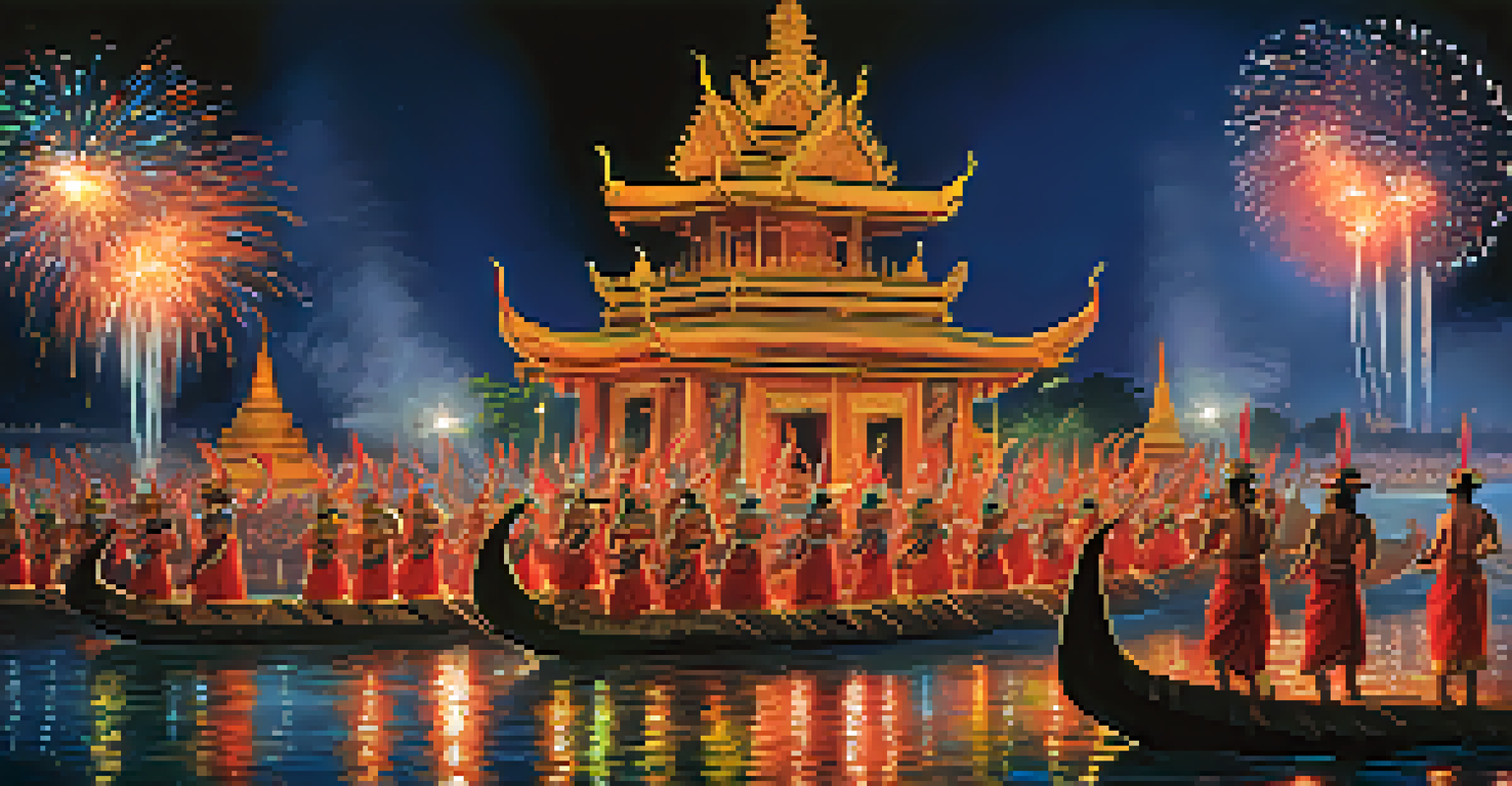The Legend of Naga: Serpent Deity in Thai Folklore

Introduction to Naga: Thailand's Serpent Deity
In Thai folklore, Naga is a revered serpent deity, embodying water and fertility. Often depicted as a giant serpent, Naga holds a significant place in Buddhist and Hindu traditions. These mythical beings are not only protectors of the rivers but also symbolize prosperity and abundance.
Mythology is not a lie; mythology is a truth that has lost its way.
The Naga’s rich narrative weaves through the cultural fabric of Thailand, appearing in various stories and art forms. From temple murals to local legends, the presence of Naga is omnipresent, enchanting those who hear its tales. It serves as a reminder of the deep connection between nature and spirituality in Thai culture.
Naga's allure extends beyond mere mythology; it reflects the beliefs and values of the Thai people, showcasing how folklore can shape societal norms. Understanding Naga's role offers insight into Thailand's historical and spiritual landscape, making it a fascinating subject to explore.
Origins of Naga in Southeast Asian Mythology
The concept of Naga is not unique to Thailand; it can be traced back to ancient Indian texts and is prevalent across Southeast Asia. In Hinduism and Buddhism, Naga appears as a powerful being, often associated with water and protection. These ancient texts describe Naga as guardians of treasures and sacred knowledge.

As the legend spread, Naga adapted to the local beliefs of various cultures, taking on different forms and attributes. In Thailand, Naga is often seen as a benevolent creature, unlike its sometimes fearsome depiction in other cultures. This adaptability highlights the fluid nature of mythology, allowing it to resonate with different audiences.
Naga: Symbol of Thai Culture
Naga embodies the duality of nature in Thai culture, representing both nurturing and destructive forces.
The fusion of Naga into Thai culture showcases the region's rich historical tapestry, where indigenous and foreign influences blend seamlessly. This shared mythology fosters a sense of unity among diverse communities, emphasizing the importance of Naga in the cultural identity of Southeast Asia.
Symbolism of Naga in Thai Culture
Naga symbolizes more than just a mythical serpent; it embodies the duality of nature – both nurturing and destructive. In many tales, Naga is linked to water, representing life-giving resources essential for agriculture and sustenance. This duality reflects the Thai people's respect for nature and their understanding of its power.
Folklore is the heart of a culture, revealing its values, beliefs, and traditions.
In Thai art and architecture, Naga frequently appears as a decorative element, especially in temples. Its image is often crafted into intricate designs, showcasing the skill and creativity of Thai artisans. These representations serve not only as aesthetic features but also as spiritual symbols, inviting blessings and protection.
Moreover, Naga's symbolism extends into festivals and rituals, where it plays a crucial role in ceremonies celebrating water and fertility. These practices illustrate how deeply intertwined Naga is with the cultural and spiritual practices of the Thai people, reinforcing its importance in their daily lives.
Naga in Thai Buddhist Traditions
In Thai Buddhism, Naga is often depicted as a protector of the Buddha and his teachings. Legends tell of Naga offering shelter to Buddha during his meditation, symbolizing the harmony between nature and enlightenment. This portrayal elevates Naga's status from mere myth to a significant spiritual figure.
Temples across Thailand frequently feature Naga sculptures, particularly at stairways leading to sacred spaces. These majestic representations serve as guardians, inviting devotees to approach with reverence. The presence of Naga in these sacred sites highlights the intertwining of spirituality and mythology in Thai Buddhism.
Naga's Role in Buddhism
In Thai Buddhism, Naga serves as a protector of the Buddha, highlighting the harmony between nature and spiritual enlightenment.
The stories surrounding Naga and Buddha not only enrich Buddhist teachings but also serve as moral lessons. They remind followers of the importance of compassion, protection, and respect for all living beings, further embedding Naga into the spiritual consciousness of the Thai people.
Naga in Thai Festivals and Celebrations
Naga plays a prominent role in various Thai festivals, particularly those celebrating water and fertility. The annual Naga Fireball Festival in Nong Khai is a captivating event where locals believe Naga emerges from the Mekong River, producing fireballs as a sign of blessings. This vibrant celebration showcases the deep-rooted cultural significance of Naga in the community.
During such festivals, traditional dances and rituals are performed to honor Naga, reflecting the symbiotic relationship between the people and this serpent deity. Participants dress in colorful costumes, embodying the spirit of Naga, and engage in activities that promote unity and gratitude. These events are not only a spectacle but also a testament to the enduring impact of folklore on modern Thai culture.
The lively atmosphere of these festivals fosters a sense of community, bringing people together in celebration and reverence for Naga. Such events ensure that the legend of Naga continues to thrive, passing down stories and traditions from one generation to the next.
Modern Interpretations of Naga in Art and Literature
In contemporary Thailand, Naga continues to inspire artists and writers, manifesting in various forms of creative expression. Modern literature often revisits Naga's legends, reinterpreting them for new audiences while preserving their core themes. This revitalization highlights the timeless nature of these stories, making them relevant in today's world.
Visual artists also draw from Naga's rich symbolism, incorporating it into paintings, sculptures, and installations. These works frequently explore themes of identity, spirituality, and the natural world, echoing the deep connections that Naga represents. Through these mediums, artists contribute to the ongoing dialogue about culture and mythology in Thailand.
Celebrating Naga in Festivals
Naga plays a central role in various Thai festivals, such as the Naga Fireball Festival, emphasizing its cultural significance and community ties.
Moreover, Naga's representation in popular culture, such as films and television, showcases its versatility and appeal. This modern portrayal ensures that the legend of Naga remains vibrant and accessible, captivating audiences and fostering a renewed appreciation for Thai folklore.
Conclusion: The Enduring Legacy of Naga
The legend of Naga is a captivating journey through the heart of Thai culture and spirituality. As a symbol of protection, abundance, and the interconnectedness of life, Naga resonates deeply with the Thai people. Its stories reflect the values and beliefs that have been passed down through generations, reinforcing a sense of identity and tradition.
In an ever-changing world, the enduring legacy of Naga serves as a reminder of the importance of folklore in shaping cultural narratives. It invites us to explore our own connections to nature and spirituality, encouraging a deeper understanding of our place in the world. The tales of Naga continue to inspire, educate, and entertain, ensuring that this serpent deity remains a cherished part of Thai heritage.

As we delve into the rich tapestry of Naga's stories, we uncover not just a mythical creature but a profound symbol of human experience. The legend of Naga will undoubtedly continue to thrive, captivating hearts and minds for years to come.